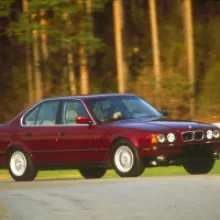SHERIDAN, WYOMING – April 8, 2025 - BMW’s early growth in the U.S. market set a powerful precedent
In the wake of taking over from Max Hoffman, BMW of North America experienced a steady climb in automobile sales. From 26,040 units in 1976 to a staggering 96,759 in 1986, the brand’s momentum seemed unstoppable. The success was attributed not only to a sharpened sales and distribution network but also to BMW’s distinct position in the premium auto segment.
While American brands like Cadillac and Lincoln emphasized plush interiors, and Mercedes-Benz and Volvo focused on safety and solidity, BMW carved out a niche by offering well-engineered, exhilarating cars under the “Ultimate Driving Machine” banner. But as BMW soared, so too did the challenges waiting just around the corner.
Currency pressures and pricing missteps posed serious setbacks
BMW’s reliance on imports made its vehicles particularly vulnerable to currency fluctuations. After the U.S. dollar was decoupled from gold in 1971, the dollar began a turbulent journey against the Deutschmark, affecting vehicle prices significantly.
“The late 1980s were a tumultuous time,” recalled Carl Flesher, former VP of Marketing at BMW NA. The price of a four-door 3 Series surged from $20,055 in 1986 to $28,400 by 1988—yet only reflected half the exchange-rate impact. This steep rise didn’t stop at compact models.
“The 7 Series with an inline six-cylinder was at $49,500, and the president wanted to take the price up by $5,000,” Flesher explained. “We went from 13 or 14,000 units a year straight down to 6,000 a year, just like that.”
Ownership costs fueled a “Break My Wallet” perception
Beyond sticker shock, customers began associating BMW with high maintenance costs. Rich Brekus, a BMW owner and later employee, shared a familiar frustration: “You’d take your new BMW in for an oil change...and you’d have a $1,500 service bill for what should have been a $100 oil change.”
This reputation became increasingly detrimental as BMW faced fierce new rivals from Japan.
Lexus arrives—and resets the luxury standard
In 1989, Toyota launched its luxury brand, Lexus, alongside Nissan’s Infiniti, following Acura’s earlier success. Lexus, in particular, shook the premium market with its LS 400. With a powerful yet efficient V8 engine, a $35,000 price tag, and a wealth of standard features, the LS 400 offered unbeatable value.
Lexus even redefined customer service. When a defect was found in the third brake light, Lexus recalled all 8,000 vehicles, offered loaners, and returned repaired, freshly washed vehicles to owners in just 20 days.
“No one had ever done that, and it changed the whole dynamic of the industry,” said Larry Demski, then a regional technical specialist at BMW NA.
BMW responds—with humility, strategy, and action
BMW took the challenge seriously. Under the leadership of new CEO Karl Gerlinger, BMW began rethinking its entire U.S. approach. Pricing became more strategic, customer service standards were raised, and maintenance was included in the cost of new vehicles to combat the “Break My Wallet” label.
“We made a concerted effort to make sure the dealer was representing the brand the way the brand should be represented,” said an insider on BMW's new customer-first approach.
New products and improved service spark a turnaround
BMW reintroduced the four-cylinder 318i for $21,500, offering more affordable entry points while continuing to innovate at the high end with the 850i V12. However, 1991 sales dipped to 53,343 units as the market adjusted.
“The Japanese were really cleaning our clock, to be honest,” said Victor Doolan, who joined BMW of North America in late 1991. But BMW didn’t back down—it improved. By 1992, sales rebounded to 65,683 units, launching nearly two decades of sustained growth.
An enduring lesson in resilience and reinvention
BMW of North America’s journey in the late ’80s and early ’90s is more than a tale of market disruption—it’s a testament to resilience. The company listened, adapted, and ultimately emerged stronger. From pricing strategy to after-sales care, BMW redefined itself to meet and exceed evolving consumer expectations.
BMW continues to deliver on its brand promise with an unwavering focus on quality, customer experience, and driving pleasure. To explore the current range of vehicles and learn more about BMW’s legacy, visit www.bmwusa.com.
